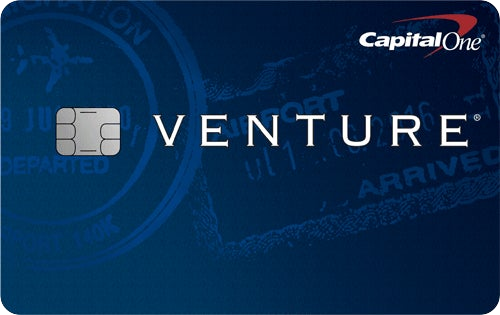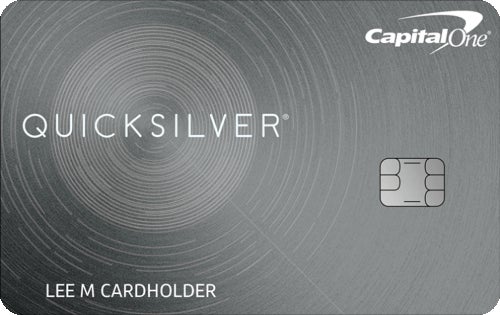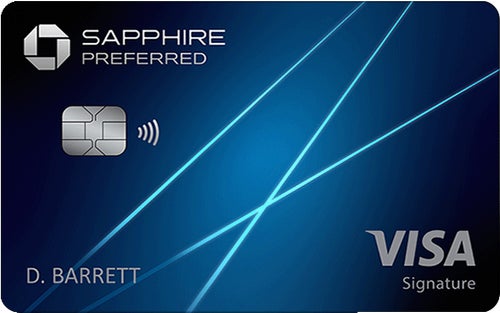If you’re looking for a flat-rate rewards credit card with a low annual fee, both the Capital One Quicksilver Cash Rewards Credit Card* and the Capital One Venture Rewards Credit Card* are great options. Both cards offer good rewards regardless of the purchase category.
The no-annual-fee Quicksilver is a lean, straightforward cash-back rewards credit card that works well as a main credit card or as a supplement to more specialized credit cards. It’s also great for those who plan to spend less than an average of $1,600 per month on it. If you spend more than that, the Venture’s higher rewards should net you more than the Quicksilver, even considering the Venture’s $95 annual fee.
The $95 Venture is technically a travel rewards credit card that offers rewards in the form of miles, but it still offers a flexible redemption process. The Venture is better for those who plan to spend more than about $1,600 per month to fully account for the annual fee, but with a generous welcome offer and a few other perks, it’s a good option regardless.
In most situations, the Capital One Venture credit card offers the better overall value. The extra rewards, redemption flexibility, and welcome offer are big advantages.
Comparing annual fees
Winner: Capital One Quicksilver
Having no annual fee is a big deal. If you pay off your balance every month, holding a no-annual-fee credit card poses little financial risk. That makes all the rewards you earn even sweeter.
As we’ll see, the Venture’s $95 annual fee may be worth it, but your pocketbook will take a hit at the outset. (Yes, I said pocketbook, and no, I’m not smoking a cigar and writing this on a typewriter.)
Welcome bonuses
Winner: Capital One Venture
There are two elements to a welcome bonus: the spending threshold cardholders need to reach, and the reward itself. The Quicksilver’s spending threshold is $500 within the first 3 months, which is a very low bar to earn the $200 cash.
On the other hand, the Venture’s spending threshold is $4,000 within the first 3 months. Even though it’s a much higher bar, the Venture’s 75,000 miles are worth $750 in travel with the potential for even more if you transfer them to a travel partner. That’s a big enough difference that we give the edge to Venture for this category. Just make sure you’re not bending your spending out of shape to hit $4,000.
Rewards
Winner: Capital One Venture
The Capital One Venture will earn you the highest net returns on your spending, despite rewards being earned in miles rather than in cash back. The Venture Card has a redemption trick up its sleeve: You can redeem Capital One Miles as a statement credit, and apply it toward travel purchases from the last 90 days.
That makes the miles as good as cash if you’re truly looking for a travel credit card, since you can redeem them against past purchases instead of needing to book travel through Capital One or transfer the miles.
The other advantage of the Venture’s rewards program is the transfer option. Venture cardholders can transfer miles to one of more than 15 travel partners, including Air France, British Airways, Virgin, and more. When transferring miles and redeeming them through the partner’s reward program, you can often get more than one cent per mile, and the value tends to go up when booking longer-haul or business- and first-class.
Rewards redemption
Winner: Capital One Quicksilver
We love cash back rewards credit cards, since there’s very little effort required to redeem the rewards, they’re consistent, and you don’t have to worry about rewards charts or blackout dates. Earning 2x miles on general purchases on the Venture compared to 1.5% cash back on the Quicksilver adds up over time ($19,000 of annual spending would net you an extra $95 in rewards), but not enough to supplant King Cash.
Travel perks
Winner: Capital One Venture
Neither card boasts a long list of extra benefits, but the Venture’s travel perks are nice boosts for those who can use them. The Quicksilver, on the other hand, doesn’t offer much at all.
With the Venture, cardholders get one statement credit every four years for either TSA PreCheck or Global Entry ($85 or $100, respectively). On top of that, you get two free one-time visits each year to Capital One lounges (Capital One is removing this benefit on the Venture Card effective 12/31/24). Capital One currently has lounges at Dallas-Fort Worth, Denver International and Washington Dulles airports.
How Capital One Venture Rewards Credit Card and Capital One Quicksilver Cash Rewards Credit Card compare to other cards
Here’s how the Venture and Quicksilver cards stack up to the Chase Sapphire Preferred® Card, which has the same annual fee as the Venture plus some sought-after features when it comes time to redeem your points. With the Sapphire Preferred, you can get more out of your points thanks to its 25% point-redemption bonus when redeeming for travel through Chase Travel℠. It also features a 1:1 point-transfer rate to Chase’s travel partners. By transferring your points, you could get even more value.
The bottom line
The main drawback of travel rewards credit cards is the complicated redemption process, but the Venture offers a way around that. Those with the time and interest in maximizing miles can do so, while those who just want to redeem them toward past purchases have that option as well. Still, if you’re not interested in paying an annual fee and you just want to earn a steady cash-back rate, the Quicksilver is a good choice.
FAQs
$19,000. The Venture offers 2x miles per dollar on your spending while the Quicksilver offer 1.5% cash back. This difference can add up over time. If you spend $19,000 in a year, you’ll earn $95 more in rewards (at a rate of 1 cent per 1 mile, when redeeming Miles for travel through Capital One or as a statement credit) with the Venture.
However, don’t forget to factor in other sources of value, like the 75,000-mile welcome offer (after spending $4,000 in the first 3 months), the PreCheck or Global Entry credit, and the lounge access.
The tool is similar to any 3rd-party booking platform, allowing you to search for fares across multiple hotel and rental car chains, with an easy-to-use interface. It also has similar pro’s and con’s to any booking tool, like losing out on hotel rewards and potentially enduring worse customer service than if you were to book directly with an airline, with the upside of easier bargain-hunting and price comparisons.
If you’re the type of traveler who isn’t too concerned with hotel elite status or who doesn’t mind booking through a 3rd-party app, the Capital One portal should be fine.
There are three main ways you can redeem Capital One Miles: 1) You can use them to book travel through Capital One travel at a rate of 1 cent per mile; 2) You can redeem them as a statement credit toward recent travel purchases at a rate of 1 cent per mile; or 3) You can transfer them to one of more than 15 Capital One travel partners.
When you transfer the Miles to an airline or hotel partner, you can sometimes get more than one cent per mile, if you do it strategically. “Strategically” means looking for redemption options on specific flights or hotel stays where the miles would be worth more than one cent.
So if you want to take a business class flight to London on British Airways, and you see that it would cost $4,000 or 300,000 Avios points, you could transfer 300,000 Capital One Miles to Avios at a 1:1 rate, then redeem those points for that flight, netting you a value of roughly 1.33 cents per Avios, or 1.33 cents per Capital One miles.
You can often get better value for business class, first class, and international flights, so don’t expect to get 1.33 cents per mile on domestic flights around the holidays. But if you put in a little work and look for sweet spots, you can further the value of your hard-earned credit card rewards.
All information about the Capital One Venture Rewards Credit Card, Capital One Quicksilver Cash Rewards Credit Card has been collected independently by CNET and has not been reviewed by the issuer.
The editorial content on this page is based solely on objective, independent assessments by our writers and is not influenced by advertising or partnerships. It has not been provided or commissioned by any third party. However, we may receive compensation when you click on links to products or services offered by our partners.



